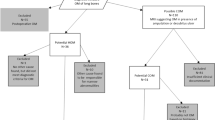Abstract
Objective To describe the magnetic resonance (MR) appearances of the bone marrow of children’s feet and to determine their frequency and significance.
Design and patients. A review of MR studies obtained in a retrospective series of 35 children with foot pain and in a prospective series of 19 asymptomatic children was performed. The MR appearances on T1-weighted, T2-weighted and STIR sequences were assessed and the frequency of patchy areas of low signal intenstiy on T1-weighted and high signal intenstiy on T2-weighted or STIR sequences was determined and correlated with clinical features.
Results and conclusions. Low signal intenstiy on T1-weighted and high signal intenstiy on T2-weighted and STIR sequences were seen in 63% of symptomatic and 57% of asymptomatic children. In all cases where both feet were imaged, the changes were seen bilaterally. The marrow pattern varied from multiple discrete foci to more extensive confluent areas of high signal on the STIR sequence. These appearances are frequent and represent normal variation in the growing skeleton, and should not necessarily be interpreted as a sign of pathology.
Similar content being viewed by others
Author information
Authors and Affiliations
Additional information
Received: 2 October 1998 Revision requested: 20 January 1999 Revision received: 18 February 1999 Accepted: 2 March 1999
Rights and permissions
About this article
Cite this article
Pal, C., Tasker, A., Ostlere, S. et al. Heterogeneous signal in bone marrow on MRI of children’s feet: a normal finding?. Skeletal Radiol 28, 274–278 (1999). https://doi.org/10.1007/s002560050515
Issue Date:
DOI: https://doi.org/10.1007/s002560050515




